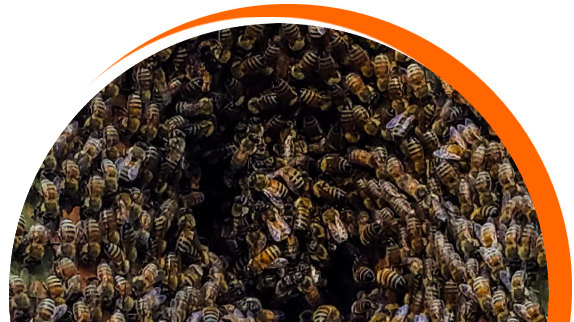Bee Control
We control Africanized honey bees, European honey bees, carpenter bees, and more

We Control Africanized Honey Bees and other Bees
Thrasher Termite & Pest Control San Diego is a participant of the Africanized Honey Bee Certification for Structural and Agricultural Pest Control Operators. We remove and control honey bees, Africanized honey bees, and wood-destroying carpenter bees.
We understand the potential danger of swarming bees and respond quickly with expert bee control service.
Bee Removal is NOT A Do It Yourself Project
Thrasher Termite & Pest Control is expert in dealing with bees and other stinging insects. Our Bee Control technicians are fully trained to deal with bees. In Southern California where Africanized honey bees are a problem, our technicians are trained in dealing specifically with this aggressive pest. Please do not attempt to remove bees or bee hives without the proper equipment and experience.
Thrasher Termite & Pest Control has been protecting California residents from bees and other stinging insects for more than 10 years. We have the training and experience to get the job done right.
We offer professional bee removal with proper equipment and procedures to provide safe areas for work and play. Our removal methods are effective and guaranteed.
The answer to most bee problems isn’t solved by simply removing the bees. Removing the bees only creates an opening for the same problem to occur. Our objective in bee control is to relocate or remove the existing infestation but also prevent it from happening again. Bee control should be a multi-step process: inspecting, relocating or removing, cleaning, and proofing. Without proper proofing the problem may reoccur causing an ongoing bee problem.
Corrective Services
Nest Removal or Elimination
- Fast acting methods and professionally trained staff.
- Relocates or Eliminates the colony and prevents dangerous bee situations.
Comb Removal
- Removal of combs and bees from established nest sites.
- Access voids in structures.
- Disinfect nest area to prevent scavenger pets.
- Apply repellant to discourage new colony relocation.
Preventive Property Survey
- Determine location of bee activity and nests.
- Identify potential problems.
Bee Proofing
- Seal cracks and openings in walls, foundation and roof.
- Fill or screen holes in trees, structures or block walls.
- Screen attic vents, irrigation boxes, and water meter box holes.
- Remove trash or debris that might shelter honey bees.
- Fill or cover animal burrows.
What to do if Attacked by a Swarm of Bees
The United States Department of Agriculture provides the following recommendations if you are attacked by a group of honey bees:
1. RUN away quickly. Do not stop to help others. However, small children and the disabled may need some assistance. As you are running, pull your shirt up over your head to protect your face, but make sure it does not slow your progress. This will help keep the bees from targeting the sensitive areas around your head and eyes.
2. Do not swat at the bees or flail your arms. Bees are aggravated by movement and crushed bees emit a smell that will attract more bees.
3. Continue to RUN. Do not stop running until you reach shelter, such as a vehicle or building. A few bees may follow you indoors. However, if you run to a well-lit area, the bees will tend to become confused and fly to windows.Do not jump into water! The bees will wait for you to come up for air. If you are trapped for some reason, cover up with blankets, sleeping bags, clothes, or whatever else is immediately available.
4. Once you have reached shelter or have outrun the bees, remove all stingers. When a honey bees stings, it leaves its stinger in the skin. This kills the honey bee so it can't sting again, but it also means that venom continues to enter into the wound for a short time.
5. Do not pull stingers out with tweezers or your fingers. This will only squeeze more venom into the wound. Instead, scrape the stinger out sideways using your fingernail, the edge of a credit card, a dull knife blade or other straight-edged object.
6. If you see someone being attacked by bees, encourage them to run away or seek shelter. Do not attempt to rescue them yourself. Call 911 to report a serious stinging attack. The emergency response personnel in your area have probably been trained to handle bee attacks.
If you have been stung more than 15 times, or are feeling ill, or if you have any reason to believe you may be allergic to bee stings, seek medical attention immediately. The average person can safely tolerate 10 stings per pound of body weight. This means that although 500 stings can kill a child, the average adult could withstand more than 1100 stings.


